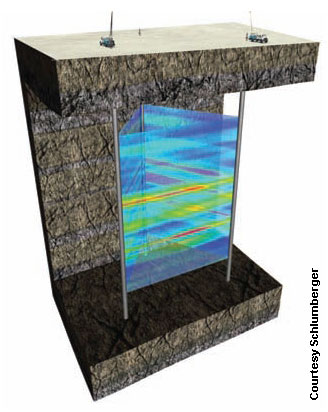簡介:
斯倫貝謝交叉井監控系統能夠勘察更深地層。該系統包括預
測井計劃、建模、模擬、數據處理和反演,并最終匯總在一起。傳統測井只能顯示井內情況, 而該系統則顯示了井間的地層情況,在波及系數監控方面比傳統地震方法更有效,其監測的井間距離可達3280英尺。
Schlumberger’s DeepLook-EM enhanced crosswell-monitoring system includes prelogging planning, modeling, simulation, acquisition, processing, and inversion, all encompassed in a logical workflow culminating in a comprehensive interpretation of interwell resistivity profiles. Where traditional wireline logs tell what is in the wells, these logs show what is between them.
The system offers much higher resolution than seismic methods for sweep-efficiency monitoring, bypassed-pay detection, and reservoir simulation optimization, and it can generate detailed images between wells up to 3,280 ft apart.

Schlumberger DeepLook-EM tomography logging fills in the gaps between wells to profile reservoir-fluid movement, locate bypassed hydrocarbons, and quantify injection sweep efficiency.
Based on induction-logging principles, the acquisition uses a dynamic transmitter sonde to log one well while an array of receivers is positioned in an offset well. Wells can be openhole or cased; the interference of the steel casing is overcome by lowering the tool’s excitation frequency. Field tests provide vital information on the efficacy of water- and steamflood programs allowing identification of flow mechanisms and imaging of potentially bypassed pay zones.
Interwell heterogeneities that affect reservoir drainage and overall fluid movement, which are invisible to seismic, can be detected and their effects analyzed. Interwell resistivity variations can be caused by subsidence (porosity reduction), changes in saturation (waterflooding), and temperature (steamflooding). By monitoring fluid movements on a reservoir scale, this system provides an understanding of and predicts reservoir dynamics more precisely than in the past.
All field data are compiled within the company’s Petrel seismic-to-simulation software, and are integrated seamlessly into the model to interpret the logged reservoir volume. Parameters are constrained within the limits of geologic sense, and the acquisition model is cross-checked against simulation results to ensure that the scenario is appropriate for the measurement. This checking provides advance assurance that the measurement is capable of delivering expected results under the given conditions.
For additional information, visit
www.slb.com/deeplook .
